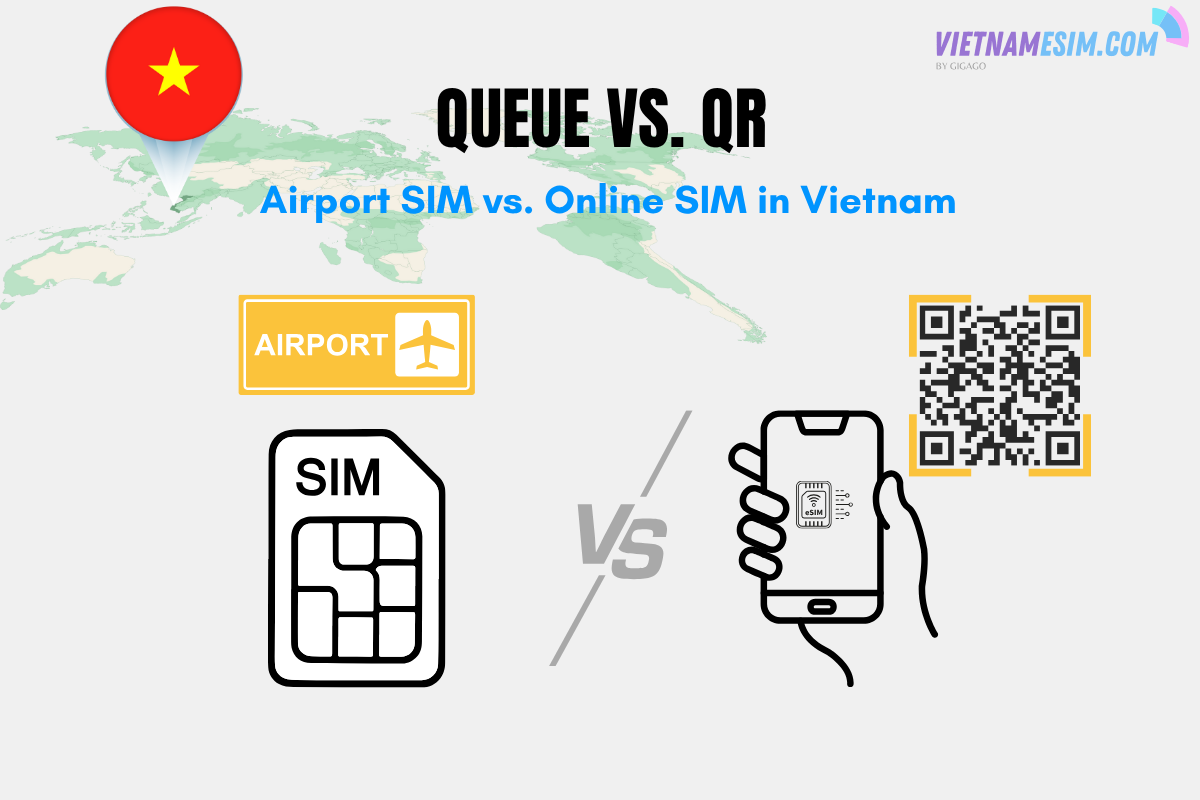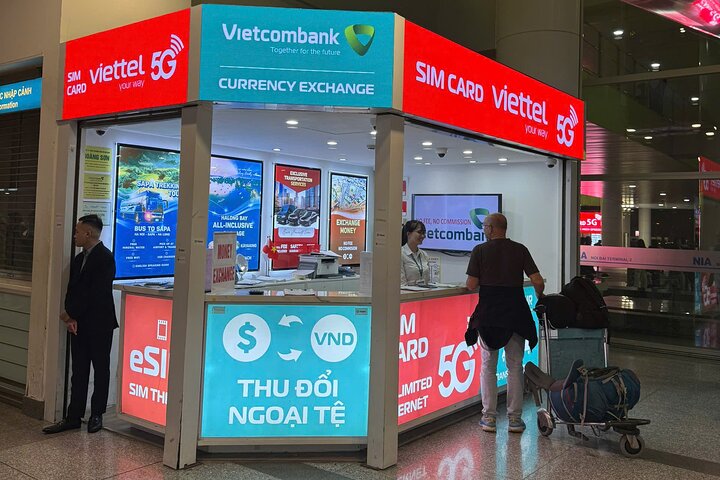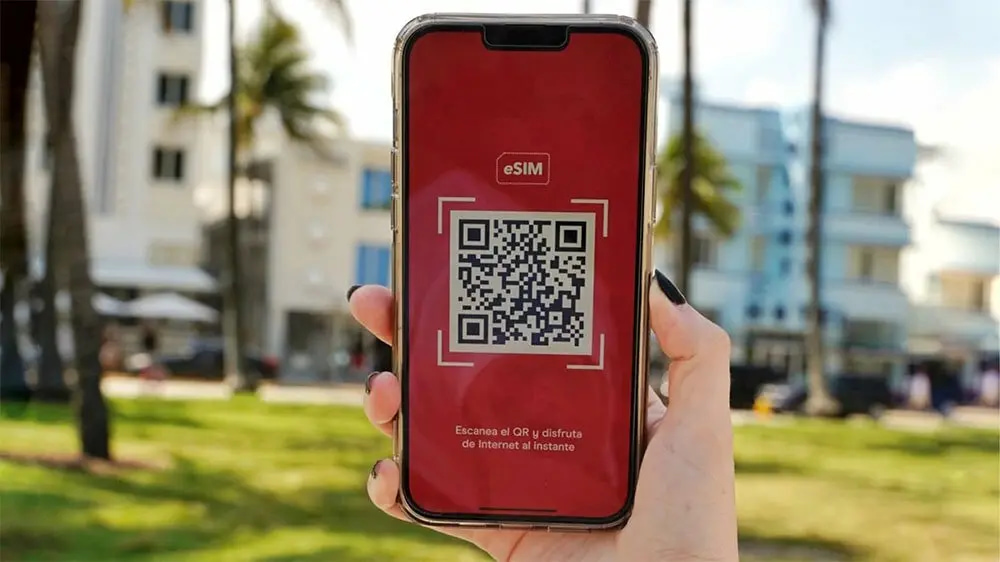Landing in Vietnam after a long flight, one of your first priorities is getting connected. Whether you need to message your hotel, book a Grab ride, navigate to your accommodation, or let loved ones know you’ve arrived safely, having mobile data is essential from the moment you land.
Today, travelers have two main options: buy traditional airport SIM or buy online SIM. Understanding the difference between Queue vs QR – queuing at an airport kiosk versus scanning a QR code can save you time, money, and considerable hassle as you begin your Vietnamese adventure.

I. What is an airport SIM?
An airport SIM is a physical SIM card you purchase from kiosks or mobile shops at arrival terminals in Vietnamese airports. These SIM cards are usually offered by local mobile providers like Viettel, Vinaphone, or MobiFone. You will find multiple vendors in the arrival areas at major airports like Tan Son Nhat in Ho Chi Minh City or Noi Bai in Hanoi. Travelers can choose from different data plans and staff are often available to help insert the SIM and activate it on the spot.
How it works:
- Approach a kiosk after clearing immigration
- Browse available plans and select one
- Provide your passport for mandatory registration
- Receive a physical SIM card
- Staff helps insert it and configure settings
- Connected within minutes (if no queue)
What to expect:
- Wait times: 20-60+ minutes during peak hours
- Available networks: Viettel, Vinaphone, Mobifone
- Price range: 200,000-400,000 VND for tourist packages
- Language barriers possible with staff
- Limited time to compare plans
- Higher prices than city rates

II. What is an online SIM (QR SIM)?
An online SIM, also called a QR SIM or eSIM, is a digital SIM card that’s already built into your device without needing a physical card. You activate it by scanning a QR code provided by your provider, typically purchased online before your trip.
The setup is fast and can be done before or after arriving in Vietnam, as long as there is an internet connection. An eSIM is convenient, flexible, and easy to manage.
How it works:
- Purchase online from home (days or weeks before travel)
- Receive QR code and instructions via email
- Scan QR code to install the digital SIM profile
- Enable the online SIM when you land in Vietnam
- Connected within minutes, no kiosk visit needed
Key features:
- Installation: Before departure or upon arrival
- Activation time: Under 5 minutes
- Dual SIM support: Keep home number active while using Vietnamese data
- Network access: Same major Vietnamese carriers (Viettel, Vinaphone, Mobifone)
- Compatible devices: iPhone XR/XS and newer, recent Samsung Galaxy, Google Pixel 3+, and most smartphones from 2018 onwards
Bonus explanation: The technology is technically known as eSIM (embedded SIM), but travelers often search for “online SIM” because you buy it online, or “QR SIM” because you activate it by scanning a QR code.

III. Compare Airport SIM vs Online SIM
Both airport and online eSIMs help travelers stay connected in Vietnam, but they offer different experiences.
| Feature | Airport SIM | Online SIM (QR SIM) |
| Time and convenience | 20-60 minutes (queue + setup) | 3-5 minutes (no queue needed) |
| Cost | 200,000-400,000 VND, premium airport pricing | 15-30% cheaper, transparent online rates |
| Setup Process | Physical card swap | Scan QR code |
| Plan Selection | Limited to what’s available at kiosk | Wide variety (Vietnam-only or regional) |
| Device Compatibility | Works with all phones | Requires eSIM-compatible smartphone |
| Customer Support | In-person at airport shop | 24/7 online support (e.g., Vietnamesim.com with live human) |
| Payment Methods | Often cash or local cards only | International credit/debit cards accepted |
| Best for | Travelers with older phones, those who prefer face-to-face help | Modern smartphones, travelers who value time and convenience |
Overall, eSIMs provide a faster, more flexible option for modern travelers, while airport SIMs can be useful for those who prefer face-to-face assistance.
IV. Who should choose each option?
Choose Airport SIM if you:
- Have a phone that doesn’t support eSIM technology
- Forgot to arrange connectivity before departure
- Don’t mind waiting in queues
- Prefer handling everything in person
Choose Online eSIM if you:
- Own an eSIM-compatible phone (From iPhone XR+, Samsung Galaxy S20+, Google Pixel 3+)
- Value time and want instant connectivity upon landing
- Need to keep your home number active for calls/SMS
- Are visiting multiple Southeast Asian countries
- Prefer researching options thoroughly before purchase
V. Why are more travelers choosing eSIMs when visiting Vietnam?
Beyond the clear advantages of faster setup, lower costs, and multi-country flexibility already discussed, the eSIM adoption rate among visitors to Vietnam has grown significantly because travel expectations have changed.
Modern travelers research everything online before their trip – hotels, restaurants, attractions – so arranging connectivity the same way feels natural.
Three factors drive this shift:
- Travelers want control (purchasing at home, not under pressure at the airport).
- They prioritize seamless experiences (no queue, no language barriers).
- They’ve become comfortable with digital-only products after years of mobile tickets, digital boarding passes, and contactless payments.
For Vietnam specifically, the country’s excellent mobile infrastructure means eSIMs deliver the same quality as physical SIMs. First-time visitors particularly appreciate starting their trip already connected, ready to navigate Hanoi’s Old Quarter or book a last-minute Mekong Delta tour without hunting for WiFi first.
Ready to Stay Connected in Vietnam?
Skip the airport queue and arrive in Vietnam already connected. Vietnamesim offers eSIM plans for Vietnam-only travel or regional Southeast Asian coverage across Thailand, Cambodia, Laos, and more.
Browse plans at vietnamesim.com’s shop or contact their 24/7 support via WhatsApp at +1 657-571-1199.
